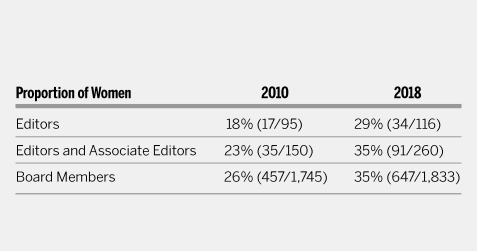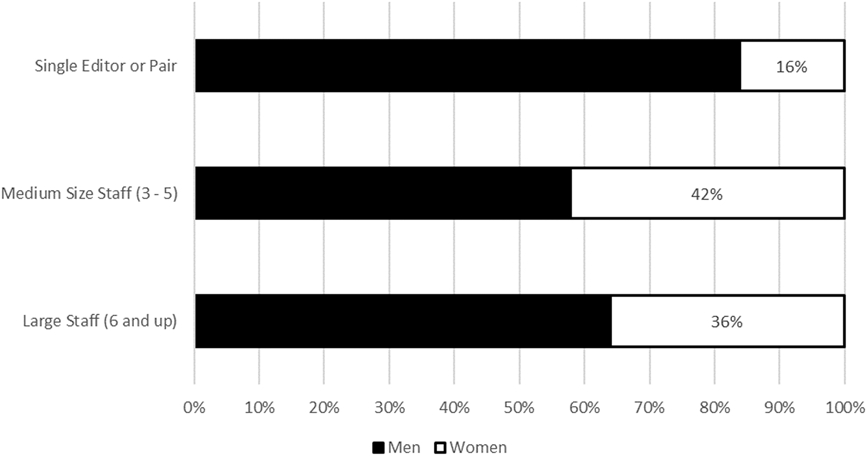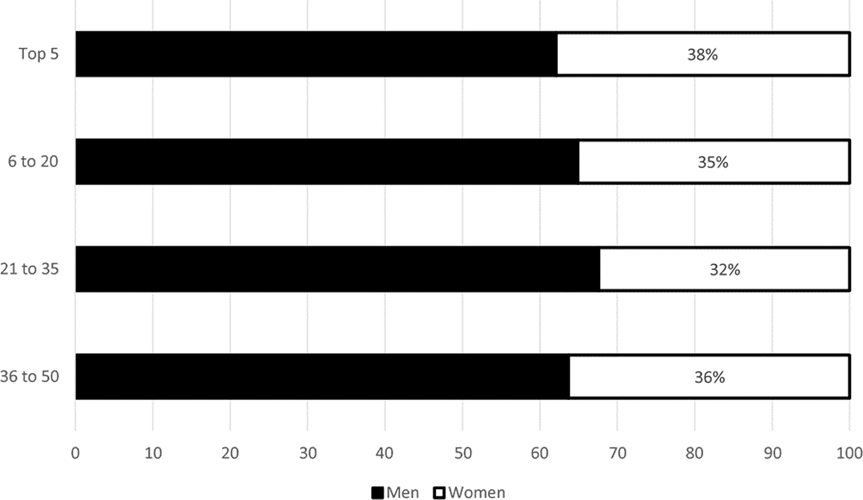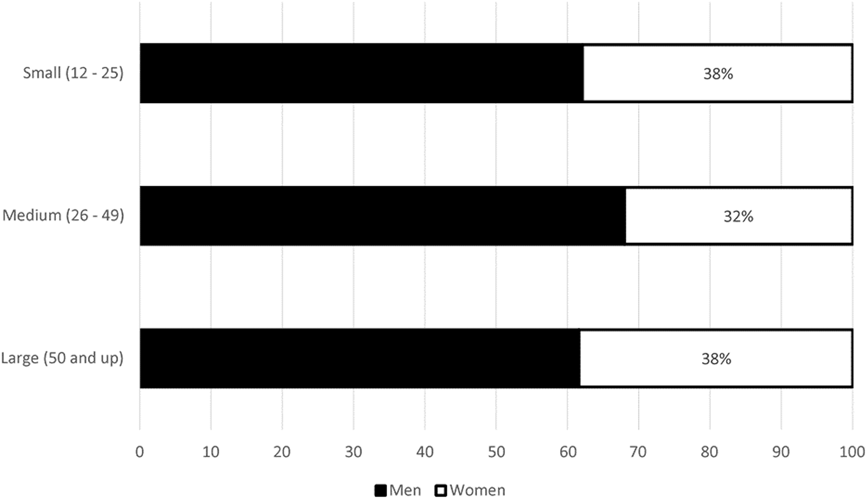An analysis of women’s representation as editors, associate editors, and board members at the top 50 political science journals in 2010 suggested that women were reasonably well represented in proportion to the ranks they held in the profession (Stegmaier, Palmer, and van Assendelft Reference Stegmaier, Palmer and van Assendelft2011). To contribute to the continuing discussion of women’s presence in journals as authors (see, e.g., Teele and Thelen Reference Teele and Thelen2017), this analysis replicates the 2010 analysis with data from 2018. Our study finds that the representation of women as editors, associate editors, and board members has increased substantially since 2010 as the number and proportion of women in the discipline has increased. Moreover, the proportion of women as editors, associate editors, and board members has tracked closely with the proportion of senior female faculty at PhD-granting institutions. However, significant variation across journals still exists.
Recent evidence suggests that women are less likely than men to submit manuscripts to journals for review. The noticeable “gender gap” in publication rates is not explained by the smaller number of women in the profession compared to men, but it raises questions about trends in collaborative research and methodological preferences that may disadvantage female authors (Teele and Thelen Reference Teele and Thelen2017). A 2005 report suggested that cultural barriers limited the research opportunities for women to collaborate with male colleagues (American Political Science Association 2005).
Former APSA President Kathleen Thelen’s Presidential Task Force on Women’s Advancement in Political Science (2016–2018) included a working group on publications that delved into the editorial processes of five political science journals to shed light on possible obstacles to women’s advancement in scholarly publications. It found no systematic evidence of gender bias in the review process (Brown and Samuels Reference Brown and Samuels2018). In the American Political Science Review, fewer than 23% of all authors from 2000 to 2015 were female, which was explained by a lower submission rate rather than a higher rejection rate for female authors. Work that was both collaborative and quantitative was more likely to survive the review process, and these collaborative teams were more likely to be male (König and Ropers Reference König and Ropers2018). At World Politics, mixed-gender teams had a greater success rate than teams of all men or all women. Solo men were published more than solo women, but they submitted the largest percentage of manuscripts. Coauthored manuscripts had a better success rate than solo submissions; again, most of the coauthored teams were male (Tudor and Yashar Reference Tudor and Yashar2018). A similar pattern was found at Comparative Political Studies, with no evidence of bias against women; coauthoring and methodology appeared to play a greater role than gender in editorial decision making. It is interesting that solo female submissions were more likely to be sent out for review than solo male submissions, but papers by collaborative female teams were even more likely to be reviewed (Samuels Reference Samuels2018). Likewise, at Political Behavior, there was no evidence of gender bias in the review process. Multiple authors, however, received more positive reviews than solo authors (Peterson Reference Peterson2018). Ironically, International Studies Quarterly implemented a triple-blind review process that was intended to reduce any potential gender discrimination, but this actually increased the number of desk rejections of female-authored manuscripts (Nedal and Nexon Reference Nedal and Nexon2018).
OUR DATA
Replicating the 2010 analysis, we used the top 50 political science journals ranked by their “relative-impact” scores created by Garand et al. (2009, 699–701). The appendices provide the complete list of these 50 journals and our counts of editors and associated editors, as well as board members for each journal from 2010, and our new data from July and August of 2018, collected from each journal’s website. Gender was determined based on first names and confirmed by finding photographs and pronouns. In the past eight years, not only has there been change in the personnel who serve as editors and associate editors and on editorial boards, some journals also have made significant changes in their editorial structure. For example, American Political Science Review decreased from eight editors (seven men and one woman) to one editor (a man). In 2010, Comparative Political Studies had 29 board members; by 2018, it had 76.
The original 2010 analysis compared the proportion of women as editors, associate editors, and board members to their proportion in the profession, particularly women in the senior ranks of associate and full professors. These data on women in the profession were obtained from the APSA Task Force on Political Science in the 21st Century (APSA 2011). Unfortunately, this study has not been replicated. APSA continues to collect data on faculty rank, type of department, and gender through membership surveys, including the 2015 APSA Member Survey and the 2017 APSA Annual Meeting Evaluation, which we used for this analysis. However, these surveys have response rates of about 25% and, of course, include only APSA members. Although these surveys provide another snapshot of the proportion of women in the field, the data are not as comprehensive or consistent with what was used in 2010; therefore, we use them recognizing their limitations.
The data in table 1 provide the proportion of women in the profession from the 2010 analysis and the two surveys mentioned previously. Because the majority of faculty serving as editors, associate editors, and board members are associate and full professors at PhD-granting institutions, we used the proportion of women in senior ranks at those institutions as our baseline comparison for most of our analysis.
Table 1 Women in the Profession

Notes: All data provided by APSA.
* Data from the 2010 “Political Science in the 21st Century” project.
** Data from the 2015 APSA Member Survey (unweighted); response rate = 25.7% (6,974/27,097).
*** Data from the 2017 APSA Annual Meeting Evaluation (unweighted); response rate = 24.4% (1,400/5,738).
THE MORE THINGS CHANGE, THE MORE THEY STAY THE SAME
Has the increased percentage of women faculty, especially at the senior ranks, led to proportionate representation in journal editorial positions?
Women as Editors
To match the 2010 analysis, our count of “editors” includes individuals with the titles of editor, editor-in-chief, senior editor, and coeditor. We did not count managing editors because of the variation in their roles and responsibilities; the position usually handles the daily administrative operations of the journal but does not have major decision-making power. Book-review editors also were not included. Few faculty hold the position of editor: only 95 in 2010 and 116 in 2018.
As shown in table 2, the number and proportion of women editors have increased. In 2010, 17 of the 50 journals had a female editor; no journal had more than one woman, making them 18% of all editors. By 2018, the proportion had increased to 29%: 21 journals had at least one female editor and eight had more than one female editor. In only eight years, the proportion increased by 11 points. However, if the proportion of female senior professors in 2018 is between 35% and 38%, then women are still not as represented as they should be—in fact, they remain about as far behind as they were in 2010.
Table 2 Women as Editorial Personnel in the Top 50 Political Science Journals, 2010 and 2018

The most common journal editorial structure is a single editor. In 2010, 20 journals had a single editor, five of which (25%) were women. In 2018, 18 journals had a single editor, four of which (22%) were women. This suggests that not much has changed regarding women’s representation at journals with this particular editorial structure.
Women as Editors and Associate Editors
Most journals have a group of associate editors who provide support to editors and assist with the review process; therefore, our analysis also includes these positions. In fact, the number of associate-editor positions has substantially increased. In 2010, there were only 55 associate editors; by 2018, their number had almost tripled to 144.
As shown in table 2, of the 150 editors and associate editors in the 2010 study, 35 (23%) were women; this was at parity, matching the proportion of senior female faculty at PhD-granting institutions. In 2018, the total number of editors and associate editors increased to 260. It is particularly encouraging that the overall number and proportion of women also increased noticeably to 91 (35%), which also matches our data on the proportion of senior female faculty at PhD-granting institutions.
Figure 1 shows the proportion of men and women as editors and associate editors by the size of editorial staff. Women are substantially underrepresented when there are only one or two people at the helm of a journal: only 16% of editors and associate editors at journals with the smallest editorial staffs are female. However, at journals with multiple people at the helm, women are much more likely to be represented. In fact, at the 15 journals with a medium-sized editorial staff of three to five people, women comprised 42% of editors and associate editors. This suggests that at journals where editors and associate editors have the most individual power—that is, those with one or two people in charge—women are still relatively rare.
Women are substantially underrepresented when there are only one or two people at the helm of a journal: only 16% of editors and associate editors at journals with the smallest editorial staffs are female.

Figure 1 Proportion of Men and Women Editors and Associate Editors by Size of Editorial Staff
However, the prestige of a journal does not seem to make a difference in women’s representation. As figure 2 reveals, regardless of the journal’s Garand et al. (Reference Garand, Giles, Blais and McLean2009) relative-impact score, the proportion of women as editors and associate editors is close to that of senior female faculty at PhD-granting institutions; in the case of the top five journals, the proportion was actually slightly higher.

Figure 2 Proportion of Men and Women Editors and Associate Editors by Journal Rank
The complete list of journals in online appendix A shows that the number at parity was 19 of 50 in 2010; in 2018, it was still 19 of 50. In the eight years since the first study, the number of journals at 50% female or more increased by one, from 12 to 13. However, it is important to note that 23—nearly half—of the 50 journals increased the proportion of women in these positions; 18 remained the same. Eight journals decreased in their proportion of women as editors and associate editors; however, almost all had made dramatic changes in their editorial structure that accounts for the decline. For example, in 2010, Political Theory had one editor—a woman—and no associate editors, resulting in 100% female personnel. In 2018, the journal had 10 editors and associate editors—four men and six women—resulting in 60% female editorial staff. Therefore, the conclusion that the proportion of women “declined” does not tell the whole story. In 2010, there were relatively few associate editors, and the inclusion of women in these positions was sporadic. By 2018, the position of associate editor was far more common and appears to be a place where women are making inroads.
For each of the two years in this study, we ranked the journals based on the proportion of women as editors and associate editors (journals that tied were given the same rank). In 2010, the journals were ranked first to 13th; journals that ranked 13th had no women editors or associate editors. In 2018, the journals were ranked first to 18th; journals that ranked 18th had no women editors or associate editors. This reveals that the journals with the highest proportion of female editors and associate editors in 2010 were, for the most part, the same as those in 2018. In 2010, 25 (50%) of the journals had no women editors or associate editors. In 2018, 17 of these journals still had no women in those positions. The journals on the bottom in 2010 were still on the bottom eight years later. Overall, there has been an increase in the presence of women as editors and associate editors, but the increase has been mainly at journals that already had a significant proportion of women in these positions.
Overall, there has been an increase in the presence of women as editors and associate editors, but the increase has been mainly at journals that already had a significant proportion of women in these positions.
Women as Board Members
All of the journals, except Foreign Affairs and Journal of Law and Economics, have some type of editorial board. These boards vary significantly in size, and some journals dramatically changed the size of their board between 2010 and 2018. The role of board members also varies but includes serving as referees or experts, soliciting articles, and participating in discussions about the mission of the journal; service on a journal’s board is a form of professional recognition. Editorial boards provide an “opportunity for journals to select a diverse group of scholars to provide guidance and to raise the profile of the journal” (Stegmaier, Palmer, and van Assendelft Reference Stegmaier, Palmer and van Assendelft2011, 801). In contrast to the relatively few editors and associate editors, numerous faculty serve on these boards. As shown in table 2, the total number of faculty serving on boards increased from 1,745 to 1,833 and the proportion of women increased from 457 (26%) to 647 (35%), keeping pace with the proportion of women in the profession at senior ranks at PhD-granting institutions.
However, it is important to keep in mind that whereas these boards might be dominated by senior faculty, junior faculty often are asked to serve on boards as well. Comparing these data to the proportion of female faculty at all ranks and all institutions, the picture becomes murkier. In 2010, the 26% of women serving on boards was close to all of these proportions: women were 25% of senior faculty at PhD-granting institutions, 23% of senior faculty at all institutions, and 29% of all faculty at all institutions. In 2018, the 35% of women serving on boards aligned with female senior faculty at PhD-granting institutions (35%–38%) and the overall proportion of female faculty at all ranks in the 2015 survey (38%). However, if the overall proportion of women in the field at all institutions is closer to the 44% determined by the 2017 survey, this suggests that women might be falling behind.
Although the proportion of female editors and associate editors differed substantially based on size of the editorial staff, women’s representation on boards does not seem to be related to the size of the board. Figure 3 suggests that women are found in approximately the same proportion on small, medium-sized, and large boards.

Figure 3 Proportion of Men and Women by Size of Board
Regarding the prestige of journals indicated by their Garand et al. (Reference Garand, Giles, Blais and McLean2009) relative-impact scores, as shown in figure 4, women comprised 47% of board members at the top five political science journals, suggesting that women are well represented. At the remaining 45 journals, the proportion of women ranged from 33% to 36%.

Figure 4 Proportion of Men and Women Board Members by Journal Rank
As indicated in online appendix B, 32 journals (64%) increased the proportion of women on their board, two stayed the same, and 13 decreased. However, the decline among these 13 journals was less than 5% for nine of them. Using the proportion of female senior professors at PhD-granting institutions as the baseline, in 2010, 23 journals—nearly half—were at parity, at 25% or more women; one journal, Canadian Journal of Political Science, was at 50%. In 2018, 24 journals were at parity, with 35% or more women on their board; eight journals had 50% or more on their board. In 2018, American Political Science Review had the highest proportion of women, with its editorial board 67% female. At the other end of the spectrum, in 2010, 15 journals had a board with fewer than 20% women. In 2018, nine still had less than 20%; six of these were the same journals from 2010. History of Political Thought is the only journal that had no women in 2010 and still had no women in 2018. Similar to 2010, although women were reasonably well represented overall in 2018, there is still significant variation among journals concerning the proportion of women on editorial boards.
We again ranked the journals based on the proportion of women as board members (journals that tied were given the same rank). In 2010, the journals were ranked first to 45th; in 2018, the journals were ranked first to 43rd. Two journals have significantly increased the presence of women on their board. International Affairs ranked 41st in 2010 with its board being 11% female; however, eight years later, it ranked fourth, with its board being 54% female. Comparative Political Studies, ranked 44th in 2010 with its board only 10% female, was ranked eighth in 2018, with its board 47% female. In 2010, only three of the 29 board members were women, whereas in 2018, 36 of 76 members were women. Although the top 10 in 2010 were not, for the most part, the top 10 in 2018, all but one journal in the top 10 in 2018 were among the top 20 in 2010. In other words, journals that already had significant representation of women in 2010 still had significant representation in 2018. With one exception—Legislative Studies Quarterly, which dropped from 20th to 40th—the journals at the bottom were still those at the bottom in 2018.
CONCLUSIONS
In 2010, women were reasonably well represented as editors, associate editors, and board members compared to their proportions as senior faculty at PhD-granting institutions; the data from 2018 suggest a continuation of that trend, with some caveats. Women are still underrepresented as editors, particularly at journals with one or two editors and associate editors, which is where these positions have the most power. However, as the number of associate editors has grown, so has the proportion of women in these positions. This could bode well for women increasing their presence as editors, if associate editors provide a pool from which to select editors. Women are well represented on the board of the top five journals in the profession; however, at the majority of journals, their proportion as board members only matches their proportion at the senior ranks at PhD-granting institutions. Because journal boards are more likely to include junior faculty, this suggests that women may be falling behind. In fact, because it has substantial implications for the “pipeline” into editorships, an important issue to explore in the future is the gender distribution of junior and senior faculty as board members and associate editors. There remains significant variation among journals, but most of those with the highest proportion of women as editors, associate editors, and board members in 2010 were the same journals in 2018.
In 2010, women were reasonably well represented as editors, associate editors, and board members compared to their proportions as senior faculty at PhD-granting institutions; the data from 2018 suggest a continuation of that trend, with some caveats.
In addition to investigating the ranks of faculty serving in all editorial positions, it would be useful to explore differences among types of journals, such as those that publish articles covering a broad range of subfields compared to those that are more specialized, or journals that publish quantitatively oriented articles compared to those that publish more qualitative research. When journals changed their editorial structure, did they consider the impact of the changes on the diversity of their personnel? If one way that journals increase the number of women in editorial positions is by increasing the number of positions, does this dilute women’s power? Ultimately, more research is needed on journals that have reached gender parity and the difference that gender balance in editorial leadership can make.
SUPPLEMENTARY MATERIAL
To view supplementary material for this article, please visit https://doi.org/10.1017/S1049096520000190
ACKNOWLEDGMENTS
The authors thank Charley Nuesse and Jackie Yavornitzky at Baldwin Wallace University and Jordan Weinberg at the University of Missouri for their assistance with data collection, editing, and proofreading.










